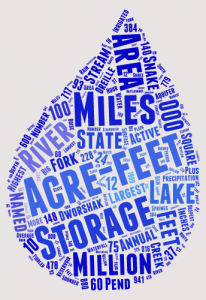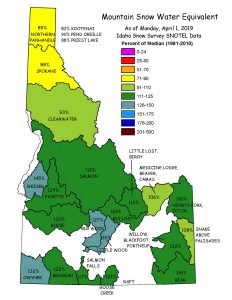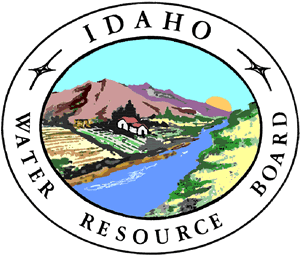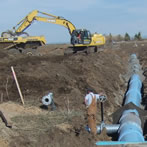- File an Application for a Permit or Statutory Claim to a Water Right with IDWR. The information that must be included in the application is described by statute and in IDWR’s rules and regulations.
- IDWR staff reviews the application or claim to ensure that it contains all the necessary information.
- Per Idaho Code § 42-203A, IDWR publishes a notice of the application or claim in the newspaper printed in the county in which the point of diversion is located. The notice details important elements of the application or claim including priority date, water source, nature of use, point of diversion, amount of water, period of use, and so forth. At this time, other persons may file protests to the application or claim with IDWR. If protests are filed and cannot be resolved, then IDWR must hold a hearing.
- IDWR reviews the application or claim along with any hearing of record. If the application or claim meets the requirements of the statute and the rules and regulations, a permit is issued. The permit describes the appropriation to be made and the deadline within which the appropriation must be completed.
- Prior to the end of the period in which the appropriation must be completed, IDWR sends the permit holder a notice that the deadline is approaching and that the permit holder must complete and return proof of beneficial use. On the proof form, the permit holder states that he or she has completed the appropriation.
- After filing the proof form, a field examination is required. The purpose of the field examination is to ensure that water is in fact being used as described in the permit.
- The permit holder may request that the field examination be completed by IDWR. If so, the examination fee must be paid to IDWR at the time that proof is filed.
- The permit holder may choose to hire a certified field examiner not associated with IDWR. The certified field examiner must submit the report to IDWR after the examination and prior to the proof due date.
- IDWR issues a license that describes the appropriation.
IDWR follows a specific administrative process with all applications for a new water right, applications to change an existing water right, or new statutory claim. This process begins when you file the application or claim with IDWR and pay the required fee.
- File an Application for a Permit or Statutory Claim to a Water Right with IDWR. The information that must be included in the application is described by statute and in IDWR’s rules and regulations.
- IDWR staff reviews the application or claim to ensure that it contains all the necessary information.
- Per Idaho Code § 42-203A, IDWR publishes a notice of the application or claim in the newspaper printed in the county in which the point of diversion is located. The notice details important elements of the application or claim including priority date, water source, nature of use, point of diversion, amount of water, period of use, and so forth. At this time, other persons may file protests to the application or claim with IDWR. If protests are filed and cannot be resolved, then IDWR must hold a hearing.
- IDWR reviews the application or claim along with any hearing of record. If the application or claim meets the requirements of the statute and the rules and regulations, a permit is issued. The permit describes the appropriation to be made and the deadline within which the appropriation must be completed.
- Prior to the end of the period in which the appropriation must be completed, IDWR sends the permit holder a notice that the deadline is approaching and that the permit holder must complete and return proof of beneficial use. On the proof form, the permit holder states that he or she has completed the appropriation.
- After filing the proof form, a field examination is required. The purpose of the field examination is to ensure that water is in fact being used as described in the permit.
- The permit holder may request that the field examination be completed by IDWR. If so, the examination fee must be paid to IDWR at the time that proof is filed.
- The permit holder may choose to hire a certified field examiner not associated with IDWR. The certified field examiner must submit the report to IDWR after the examination and prior to the proof due date.
- IDWR issues a license that describes the appropriation.
For an application which has no protests, which meets the requirements of the statute and the rules and regulations, and which encounters no problems, this process takes approximately three months from the time the application is filed.
To file a protest against an application, you must do the following per Idaho Code § 42-203A.
- The Notice of Protest must be RECEIVED by IDWR no later than 10 days after the publication of the second (and last) legal notice. The last date for protest is included in the legal notice.
- The Notice of Protest must include the name and address of the person making the protest (the protestant) and must be signed by the protestant, or the protestant’s agent or attorney. The protest must be accompanied by a non-refundable $25 protest fee per application (Idaho Code § 42-221).
- The protestant must clearly describe why they object to the approval of the application. It is important that the objections be stated in clear, concise terms that accurately and clearly describe the nature of the objection and how the protestant will be injured if the application is approved.
- The protestant must send a copy of the Notice of Protest to the applicant.
If you protest a water right application, you and the applicant are given the opportunity to resolve the problem. If you cannot resolve the problem, then either of you may request that IDWR schedule a formal hearing. The hearing is a legal process where evidence can be presented and testimony taken by a hearing officer.
After the hearing, the IDWR hearing officer reviews all evidence and testimony, and then issues a recommended order which is a document detailing the recommended decision in the case. The record is also reviewed by the IDWR director who issues a final order which sets out the formal IDWR decision. Depending on the specific application, the technical complexities involved, the number of protests, administrative appeals, court challenges, and so forth, the process can take months or even years to complete.
An application which has no protests is reviewed and analyzed by IDWR staff who determine if it meets the requirements of the statute and the rules and regulations. Provided that there are no problems encountered with the application, this process takes approximately three months from the time the application is filed.
If you are currently diverting the public waters of the state and putting the water to beneficial use, you may already have a valid water right. You might have acquired a valid water right along with your land if:
- water was used on your property before you acquired it,
- the person you acquired the property from did not “reserve” the water right in the deed conveying the property to you, and
- the water right has not been forfeited due to five or more years of non-use.
IDWR maintains records of water right permits, licenses, and decrees. Use the tools on the Research tab to find your water right information.
You might need a new water right for the following reasons.
- A water right was not properly established for the existing use (for example, if a use of surface water was initiated after 1971 without applying to IDWR for a permit).
- A new water right is needed for a new use of water.
Surface Water Rights
Prior to May 20, 1971, there were two ways to establish surface water right.
- Divert water and apply it to beneficial use. These water rights are called “beneficial use” (or “historic use” or “constitutional”) water rights. The priority date for a water right established by this method is the date water was first put to beneficial use.
- Establish a right to surface water by complying with the statutory method in effect at the time the water right was established. The current statutory method is an application/permit/license procedure. The priority date for a water right established by this method is the date of filing the application with IDWR, and this priority date is shown on the license that is issued when the process is complete. Prior to 1903, Idaho had a “posted notice” statute which provided for posting of a notice at the point of diversion and recording the notice at the county recorder’s office—followed by actual diversion and beneficial use of the water (among other things). If the statutory requirements were met, then the priority date for a water right established under the “posted notice” statute was the date of posting the notice. Water rights established under the old statutory method are called “posted notice” water rights, but are considered “beneficial use” water rights because they are not confirmed by a license or decree.
As of May 20, 1971, the only method to establish a surface water right is by following the application/permit/license procedure. The one exception to this rule is for water rights used solely for instream livestock watering.
Groundwater Rights
Prior to March 25, 1963, there were two ways to establish groundwater rights—which are the same methods described for surface water (above).
As of March 25, 1963, the only method to establish a groundwater right is by following the application/permit/license procedure. The one exception to this rule is for water rights used for domestic purposes.
Other Kinds of Water “Rights”
Some people have a right to receive water that is not an appropriation.
- Irrigation Organizations: Some people have the right to receive water that is represented by shares in an irrigation organization. In such cases, the irrigation organization has the appropriation and the water users have a right to receive water from the ditch company.
- City or Water Utility Company: Some people receive water from a city or a water utility company. The water user may have a right to receive water from the city or utility company (usually contingent upon payment of a fee), but that user does not have an appropriation.
Riparian Rights
In some states, a land owner has the right to make “reasonable use” of groundwater beneath his or her land, or water naturally flowing on, through, or along the borders of his or her land. A riparian right to make use of that water is not limited by priority date and it cannot be lost by non-use. Idaho law does not recognize a “riparian right” to divert and use water. A water right under Idaho law can be established only by appropriation, and once established, it can be lost if it is not used.
IDWR refers to the impoundment of water as storage, and generally, a water right is required for that water storage. However, your proposed impoundment might not need a storage water right depending upon the type of use, the amount of water needed, and the water source. Review the following documents to determine if you need a water right for storage purposes.
- Permitting Requirements for Ponds (Application Processing Memo No. 67) – February 28, 2003
- Maximum Daily Water Use for Domestic Purposes (for use with Application Processing Memo No. 67)
- Utilization of the 24-Hour Fill Allowance for Impoundments (Application Processing Memo No. 73) – April 18, 2013
How much storage water should I request?
After determining if a storage water right is necessary, the next step is to determine how much water to request. IDWR describes volumes in acre-feet.
Many rights to store water in a reservoir for irrigation purposes authorize a single annual filling of the reservoir. Some irrigation storage rights authorize multiple fills. Rights for purposes that require a full reservoir (such as aesthetic, recreation, and wildlife) require periodic replenishing of the reservoir to overcome seepage and evaporation losses. For help determining how much additional water is needed to overcome losses, review the following documents.
- Seepage Loss Standards for Ponds and Reservoirs (Application Processing Memo No. 76) – March 5, 2015
- Pond Loss Calculation (for use with Application Processing Memo No. 76)
IDAPA 37.03.08 – Water Appropriation Rules
Rule 35.03.b.v.
Impoundment (storage) applications shall show the maximum acre-feet requirement per year which shall not exceed the storage capacity of the impoundment structure unless the application describes a plan of operation for filling the reservoir more than once per year.
How do I describe my storage request on the application?
Once you have determined how much storage water to request, the following resources might help you depict your request on the application.
- Applications for Permit for Storage Rights (Application Processing Memo No. 14) – June 21, 1978
- Describing Water Rights with Storage Components
The point of diversion (POD), place of use (POU), period of use, or nature of use of a water right may be changed so long as the change meets certain conditions.
After May 26, 1969, any person wishing to make a change in use of the water right must file an application of transfer with IDWR for approval of the change. IDWR might approve the proposed change if it:
- will not injure other water rights,
- does not constitute an enlargement of the original water right,
- is a beneficial use,
- is consistent with the conservation of water resources within the state of Idaho, and
- is in the local public interest.
IDWR might approve the change in whole or in part, or approve it subject to conditions where necessary to meet the five requirements. If the proposed change does not meet the five requirements, then the proposed change is not approved and the application for change is denied.
Please visit the Transferring a Water Right page for more information.
There are two types of filings: statutory claim and notice of claim.
Statutory Claim
A statutory claim is filed with IDWR to make a record of an existing beneficial use right. In 1978, a statute was enacted requiring persons with beneficial use rights (other than water rights used solely for domestic purposes) to record their water rights with IDWR. The purpose of the statute was to provide some means to make records of water rights for which there were previously no records. However, these records are merely affidavits of the water users, and do not result in a license, decree, or other confirmation of the water right.
Notice of a Claim
A notice of claim to a water right is filed with IDWR in water rights adjudications. When an adjudication of a particular source is commenced, IDWR is required to notify the water users of the commencement of the adjudication, and notify the water users that they are required to file notices of claims for their water rights with IDWR. IDWR then investigates the notices of claims and prepares a report that is filed with the court. Claimants of water rights are notified of the filing of the report, and objections to the report may be filed with the court by anyone who disagrees with the findings in the report. If no objection is filed to a water right described in the report, then the court decrees the water right as described in the report. If an objection is filed to a water right described in the report, then the court determines the water right after a hearing and decrees the water right.
See the Adjudication page for more information.
Idaho Code § 42-248 requires water right owners to notify IDWR of any change of ownership or change in mailing address that applies to all water rights on file with IDWR.
Keeping the correct information on file with IDWR is especially important for claims filed as part of the Adjudication process. If claim does not reflect your current address, you could miss important procedural notices that might directly affect your water right.
If you purchase property that has with it a water right or adjudication claim, make certain that you are listed as the current owner and that your address is correct. If your water right is still pending before the court (for example, a partial decree has not yet been issued), there is no fee for filing the change of ownership form.
Claims may be corrected by the claimant only by filing an amended claim in the same format as the original. No additional filing fee is required to file an amended claim.
Use the Water Right & Adjudication Search to view water right records and associated documents.
Alternatively, you may review the original application or claim plus supporting information in the IDWR office where it was filed. To determine which IDWR office to visit, use the first two digits in the claim number which correspond to the IDWR Administrative Basins administered by the regional offices.
- Use the Water Right & Adjudication Search to obtain your claim number (which is listed as basin, sequence, and suffix).
- Go to the SRBA Subcase Summary Report page.
- In the Basin text box, type your basin number.
- In the Subcase text box, type your sequence number and suffix (if any).
- Click Submit Request.
To file an exception to a statutory claim, you must do the following per Idaho Code § 42-244.
- The exception must be filed in affidavit form.
- The exception must be filed in duplicate. IDWR will send one copy of the exception to the claimant.
- The exception should be accompanied by such proof as deemed appropriate by the person filing the exception.
No fee is required to file an exception to a statutory claim.
Exceptions to a statutory claim are made part of the claim file and are considered the same as other evidence in the file. The filing and advertising of the claim does not confirm the validity of the water right. It serves to record and preserve the information, including any exceptions, regarding the claim. No further action by IDWR is authorized.
Please visit the Certified Water Right Examiners page for more information.










